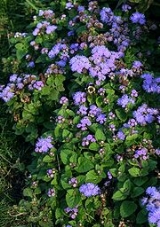
Ageratum houstonianum
Encyclopedia
Ageratum houstonianum (Flossflower, Bluemink, Garden Ageratum, Blueweed, Pussy Foot) syn. Ageratum mexicanum Hort.) is a cool-season annual plant
often grown as a bedding plant in gardens. Herb 0.3–1 m high, leaves ovate to triangular 2–7 cm long, and flowers are usually blue (though sometimes white, pink, or purple), the heads borne in dense corymbs. The ray flowers are threadlike, leading to the common name.
Native to Central America and adjacent parts of Mexico, but has become an invasive weed in other areas.
Ageratum has evolved an ingenious method of protecting itself from insects; it produces a precocene compound which interferes with the normal function of the corpus allatum
, the organ responsible for secreting juvenile hormone. This chemical triggers the next molting cycle to prematurely develop adult structures, and can render most insects sterile if ingested in large enough quantities.
when grown outside of its natural range. It has become an invasive weed in the eastern USA, Australia, Europe, Africa, China, Japan and New Zealand.
Annual plant
An annual plant is a plant that usually germinates, flowers, and dies in a year or season. True annuals will only live longer than a year if they are prevented from setting seed...
often grown as a bedding plant in gardens. Herb 0.3–1 m high, leaves ovate to triangular 2–7 cm long, and flowers are usually blue (though sometimes white, pink, or purple), the heads borne in dense corymbs. The ray flowers are threadlike, leading to the common name.
Native to Central America and adjacent parts of Mexico, but has become an invasive weed in other areas.
Ageratum has evolved an ingenious method of protecting itself from insects; it produces a precocene compound which interferes with the normal function of the corpus allatum
Corpus allatum
The corpus allatum , in insect physiology, is an endocrine gland which generates juvenile hormone; as such, it plays a crucial role in metamorphosis. Surgical removal of the corpora allata can cause an immature larva to pupate at its next molt, resulting in a miniature adult...
, the organ responsible for secreting juvenile hormone. This chemical triggers the next molting cycle to prematurely develop adult structures, and can render most insects sterile if ingested in large enough quantities.
Varieties
- Ageratum houstonianum var. angustatum B.L. Rob.
- Ageratum houstonianum f. isochroum
- Ageratum houstonianum f. luteum
- Ageratum houstonianum var. muticescens
- Ageratum houstonianum f. niveum
- Ageratum houstonianum f. normale
- Ageratum houstonianum var. typicum
- Ageratum houstonianum f. versicolor
Toxicity
Ageratum houstonianum is toxic to grazing animals, causing liver lesions. It contains pyrrolizidine alkaloids.Weed risk
A. houstonianum is prone to becoming a rampant environmental weedWeed
A weed in a general sense is a plant that is considered by the user of the term to be a nuisance, and normally applied to unwanted plants in human-controlled settings, especially farm fields and gardens, but also lawns, parks, woods, and other areas. More specifically, the term is often used to...
when grown outside of its natural range. It has become an invasive weed in the eastern USA, Australia, Europe, Africa, China, Japan and New Zealand.

